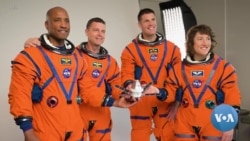ນັກບິນອາວະກາດສະຫະລັດ 3 ຄົນ ແລະນັກບິນອາວະກາດຊາວການາດາ 1 ຄົນ ຄາດວ່າຈະສ້າງປະຫວັດສາດໃນພາລະກິດອາເຕມິສ 2 (Artemis II) ຂອງອົງການ NASA ທີ່ກຳລັງຈະມາເຖິງ. ແຄນ ຟາຣາບໍ (Kane Farabaugh) ນັກຂ່າວຂອງວີໂອເອ ມີລາຍງານເພີ່ມເຕີມກ່ຽວກັບລູກເຮືອ ທີ່ມີຄວາມຫຼາກຫຼາຍ ເຊິ່ງມີກຳນົດທີ່ຈະເດີນທາງໄປດວງເດືອນ ຄັ້ງທຳອິດນັບແຕ່ປີ 1972, ເຊິ່ງອາດນາສັກ ມີລາຍລະອຽດມາສະເໜີທ່ານ ໃນອັນດັບຕໍ່ໄປ.
“ມັນເປັນເວລາຫຼາຍກວ່າເຄິ່ງສັດຕະວັດແລ້ວ ນັບຕັ້ງແຕ່ນັກບິນອະວະກາດ ໄດ້ເດີນທາງໄປດວງເດືອນ, ບັດນີ້ ມັນກໍາລັງຈະມີການປ່ຽນແປງ.”
ນັ້ນແມ່ນຄຳເວົ້າຂອງ ທ່ານບີລ ແນລຊັນ ຜູ້ບໍລິຫານອົງການ NASA ໄດ້ກ່າວໃນຂະນະທີ່ ຢືນຢູ່ຕໍ່ໜ້າພວກນັກບິນອະວະກາດໃນປັດຈຸບັນ ພ້ອມທັງຜູ້ມີປະສົບການສະໄໝຍານອາໂປລໂລ ແລະໂຄງການຍານອະວະກາດໄປ-ກັບ ໃນນະຄອນຮຸສຕັນ, ລັດເທັກຊັສ. ຜູ້ບໍລິຫານອົງການ NASA ທ່ານບີລ ແນລສັນ ໄດ້ແນະນຳ ສະມາຊິກທັງ 4 ຄົນ ຂອງຈຸບິນອາເຕມິສ 2 ເຊິ່ງລວມມີທ່ານນາງຄຣິສຕີນາ ໂຄຈ (Christina Koch), ທ່ານວິກເຕີ້ ໂຄລເວີ (Victor Glover), ທ່ານຣີດ ວາຍສ໌ແມນ (Reid Wiseman), ແລະທ່ານ ເຈເຣມີ ແຮນເຊັນ (Jeremy Hansen).
ທ່ານບີລ ເນລຊັນ ຍັງໄດ້ກ່າວຕື່ມວ່າ: “ນີ້ແມ່ນຈຸບິນຂອງມະນຸດຊາດ.”
ທ່ານຣີດ ວາຍສ໌ແມນ ແມ່ນຜູ້ບັນຊາການຢູ່ໃນພາລະກິດອາເຕມິສ 2, ໃນຂະ ນະທີ່ວິສະວະກອນຄຣິສຕີນາ ໂຄຈ ແລະທ່ານເຈເຣມີ ແຮນເຊັນ ຮັບຜິດຊອບເປັນຜູ້ຊ່ຽວຊານຢູ່ໃນພາລະກິດດັ່ງກ່າວ. ທ່ານນາງ ໂຄຈ ຈະສ້າງປະຫວັດ ສາດໂດຍການເປັນແມ່ຍິງຄົນທຳອິດ ໃນພາລະກິດເທິງດວງເດືອນ, ແລະ ທ່ານແຮນເຊັນ ເປັນນັກບິນອະວະກາດສາກົນຄົນທໍາອິດ ທີ່ຮ່ວມໃນການເດີນທາງຄັ້ງນີ້, ນັ້ນແມ່ນສິ່ງທີ່ຜູ້ບໍລິຫານອົງການ NASA ທ່ານ ເນລຊັນ ໄດ້ເນັ້ນຍໍ້າໃນລະ ຫວ່າງການປະກາດ.
ທ່ານ ເນລຊັນ ໄດ້ກ່າວວ່າ “ພວກເຮົາເລືອກທີ່ຈະກັບຄືນໄປດວງເດືອນ, ແລະ ໄປດາວພະອັງຄານ, ແລະ ພວກເຮົາກຳລັງດຳເນີນງານຮ່ວມກັນ ເນື່ອງຈາກວ່າ ຢູ່ໃນສັດຕະວັດທີ 21 ອົງການ NASA ໄດ້ສຳຫຼວດລະບົບຈັກກະວານ ພ້ອມດ້ວຍພາຄີສາກົນ.”
ທ່ານ ວິກເຕີ້ ໂຄລ-ເວີ (Victor Glover), ນັກບິນກອງທັບເຮືອສະຫະລັດ, ຈະຂັບຍານອາວະກາດ ໂອໄຣອອນ ໃນພາລະກິດໄປ-ກັບຮອບດວງເດືອນ ເປັນເວລາ 10 ວັນ ເພື່ອທົດສອບການເຮັດວຽກຂອງລະບົບ ແລະ ອຸປະກອນທີ່ລູກເຮືອໃນອະນາຄົດຈະໃຊ້ເພື່ອກັບສູ່ພື້ນຜິວດວງເດືອນໃນທີ່ສຸດ.
ໃນການໃຫ້ສໍາພາດກັບວີໂອເອ ກ່ອນພາລະກິດ ອາເຕມິສ 1 ໃນປີກາຍນີ້, ທ່ານ ໂຄລ-ເວີ ໄດ້ກ່າວວ່າ ທ່ານພ້ອມຮັບເອົາໂອກາດຄັ້ງປະຫວັດ ສາດທີ່ຈະເປັນຄົນຜິດສີຄົນທໍາອິດ ທີ່ໄດ້ຖືກມອບໝາຍໃຫ້ປະຕິບັດ ພາລະກິດເທິງດວງເດືອນ.
ທ່ານໄດ້ກ່າວວ່າ:
“ຜູ້ຄົນຖາມຂ້າພະເຈົ້າເລື້ອຍໆວ່າ, ມັນມີຄວາມໝາຍສຳລັບທ່ານບໍທີ່ເດັກນ້ອຍຜິວດຳເບິ່ງມາທີ່ທ່ານ ແລະເວົ້າວ່າພວກເຂົາເຈົ້າຢາກເປັນຄືທ່ານ? ທ່ານຮູ້ຫຍັງບໍ່? ເວົ້າແທ້ໆ, ຂ້າພະເຈົ້າເປັນຕົວແທນຂອງອາເມຣິກາ. ຂ້າພະເຈົ້າເປັນທະ ຫານເຮືອ ແລະຂ້າພະເຈົ້າເຮັດວຽກໃຫ້ອົງການ NASA. ຂ້າພະເຈົ້າເປັນຕົວແທນຂອງອາເມຣິກາ ແລະເດັກນ້ອຍຜິວຂາວ, ເດັກນ້ອຍຊາວເມັກຊິໂກ, ເດັກນ້ອຍຊາວສະເປນ, ແລະເດັກນ້ອຍຊາວອີຣ່ານ ປະຕິບັດຕາມສິ່ງທີ່ພວກເຮົາເຮັດ ເພາະວ່ານີ້ອາດຈະເປັນນື່ງໃນສັນຍາລັກທີ່ຖືກຮັບຮູ້ຫຼາຍທີ່ສຸດໃນຈັກກະວານ."
ບໍ່ພຽງແຕ່ເປັນການສ້າງປະຫວັດສາດເທົ່ານັ້ນ, ຈຸບິນອາເຕມິສ 2 ຍັງສາມາດບິນໄປໃນອາວະກາດໄດ້ໄກກວ່າມະນຸດຄົນໃດກ່ອນໜ້ານີ້, ໂດຍເດີນທາງເປັນໄລຍະທາງລວມຫຼາຍກວ່າ 1 ລ້ານກິໂລແມັດ ໃນເສັ້ນທາງທີ່ຍາວອອກໄປໄກກວ່າດວງເດືອນ ກ່ອນທີ່ຈະກັບຄືນສູ່ໂລກ. ອົງການ NASA ກ່າວວ່າ ໄລຍະທາງ ແລະແຜນການທີ່ແນ່ນອນ ແມ່ນຂຶ້ນກັບປັດໃຈຕ່າງໆຈໍານວນຫນຶ່ງ, ເຊິ່ງ ລວມທັງວັນທີຂອງການເລີ້ມພາລະກິດຕົວຈິງ.
ໃນຕອນທ້າຍຂອງພິທີແນະນຳລູກເຮືອ ຂອງອົງການ NASA, ທ່ານຣີດ ວາຍສ໌ແມນ ໄດ້ສະແດງຄວາມມຸ່ງໝັ້ນຂອງອົງການ ທີ່ຈະບັນລຸເປົ້າຫມາຍໃນອາວະກາດ ເຖິງແມ່ນວ່າຈະມີຄວາມຊັກຊ້າທີ່ຊ້ໍາຊ້ອນກັນ ແລະຄ່າໃຊ້ຈ່າຍຫຼາຍເກີນໄປ. ເຊິ່ງທ່ານ ໄດ້ກ່າວວ່າ:
"ສາມຄໍາທີ່ພວກເຮົາເວົ້າຢູ່ໃນໂຄງການ ອາເຕມິສ ນີ້ ສະເໜີແມ່ນ "ພວກເຮົາກຳລັງ." ແລະຂ້າພະເຈົ້າຕ້ອງການ ໃຫ້ທຸກຄົນເວົ້າມັນນຳກັນ, ນັບເຖິງສາມ ... ຫນຶ່ງ, ສອງ, ສາມ - "ພວກເຮົາກໍາລັງ!"
ອົງການ NASA ຫວັງວ່າຈະສົ່ງ ຍານອາເຕມິສ 2 ຂຶ້ນສູ່ວົງໂຄຈອນ ໄວທີ່ສຸດໃນເດືອນພະຈິກ 2024, ໂດຍພາລະກິດທຳອິດ ໃນການລົງຈອດທີ່ພື້ນຜິວຂອງດວງເດືອນ ໄວທີ່ສຸດແມ່ນໃນປີ 2025.
Three U.S. astronauts and one Canadian astronaut are slated to make history in NASA’s upcoming Artemis II mission. VOA’s Kane Farabaugh has more on the diverse crew scheduled to make the first lunar journey since 1972.
Bill Nelson, NASA Administrator: “It’s been more than a half century since astronauts journeyed to the moon. That’s about to change.”
Standing in Houston, Texas, before the current astronaut corps and veterans of the Apollo and Space Shuttle programs, NASA Administrator Bill Nelson introduced the four-member crew of Artemis II – Christina Koch, Victor Glover, Reid Wiseman, and Canadian Jeremy Hansen.
Bill Nelson, NASA Administrator: “This is humanity’s crew.”
Reid Wiseman is mission Commander for Artemis II, while Christina Koch and Jeremy Hansen will serve as mission specialists. Koch is set to make history as the first woman on a lunar mission, and Hansen as the first international astronaut to take such a journey, something NASA Administrator Nelson emphasized during the announcement.
Bill Nelson, NASA Administrator: “We choose to go back to the moon, and then on to Mars, and we are going to do it together, because in the 21st century NASA explores the Cosmos with international partners.”
Victor Glover, a U.S. naval aviator, will pilot the Orion spacecraft on the 10-day roundtrip mission around the moon, testing the functions of the systems and equipment that future crews will use to eventually return to the lunar surface.
In an interview with VOA before last year’s Artemis 1 mission, Glover said he embraces the historic opportunity to be the first person of color assigned to a moon mission.
Victor Glover, NASA Astronaut: “People keep asking me, is it meaningful to you that little Black kids look up to you and say they want to be like you? You know what? Let's be honest, I represent America. I'm a naval officer and I work for NASA. I represent America and little white kids, little Mexican kids, little Hispanic kids, and little Iranian kids follow what we're doing because this is maybe one of the most recognizable symbols in the universe.”
Not only is the makeup historic, the crew of Artemis II could also venture farther in space than any humans before them, traveling over 1 million total kilometers in a path that extends well beyond the moon before returning back to Earth. NASA says the exact distance and plan depends on a number of factors, including the date of the actual mission launch.
At the end of the NASA ceremony introducing his crew, Reid Wiseman expressed the determination of the agency to further its goals in space despite repeated delays and cost overruns.
Reid Wiseman, NASA Astronaut: “Three words that we keep saying in this Artemis program — “We are going.” And I want everyone to say it, on three … one, two, three – “We Are Going!”
NASA hopes to launch Artemis II as early as November 2024, with the first mission to the lunar surface as early as 2025.





